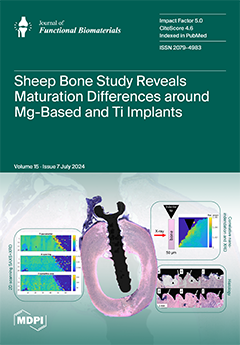The evolution of biomaterials engineering allowed for the development of products that improve outcomes in the medical–dental field. Bioglasses have demonstrated the ability to either compose or replace different materials in dentistry. This study evaluated the cytotoxicity, biocompatibility, calcium deposition, and collagen maturation of 45S5 bioglass experimental paste and Bio-C Temp, compared to calcium hydroxide (Ca(OH)
2) paste. The 45S5 bioglass and Ca(OH)
2 powder were mixed with distilled water (ratio 2:1); Bio-C Temp is ready-for-use. Dental pulp cells were exposed to the materials’ extracts (1:2 and 1:4 dilutions; 24, 48, and 72 h) for MTT and live/dead analyses. Polyethylene tubes filled with the pastes, or left empty (control), were implanted on the dorsum of 16 rats. After 7 and 30 days (n = 8/period), the rats were euthanized and the specimens were processed for hematoxylin–eosin (H&E), von Kossa (vK), and picrosirius red (PSR) staining, or without staining for polarized light (PL) birefringence analysis. A statistical analysis was applied (
p < 0.05). There was no difference in cell viability among Ca(OH)
2, 45S5 bioglass, and the control, across all periods and dilutions (
p > 0.05), while Bio-C Temp was cytotoxic in all periods and dilutions compared to the control (
p < 0.05). Regarding biocompatibility, there was a reduction in inflammation from 7 to 30 days for all groups, without significant differences among the groups for any period (
p > 0.05). The fibrous capsules were thick for all groups at 7 days and thin at 30 days. All materials showed positive structures for vK and PL analysis. At 7 days, the control and 45S5 bioglass showed more immature collagen than the other groups (
p < 0.05); at 30 days, 45S5 bioglass had more immature than mature collagen, different from the other groups (
p < 0.05). In conclusion, Bio-C Temp presented cytotoxicity compared to the other materials, but the three pastes showed biocompatibility and induced calcium deposition. Additionally, the bioglass paste allowed for marked and continuous collagen proliferation. This study contributed to the development of new biomaterials and highlighted different methodologies for understanding the characteristics of medical–dental materials.
Full article






